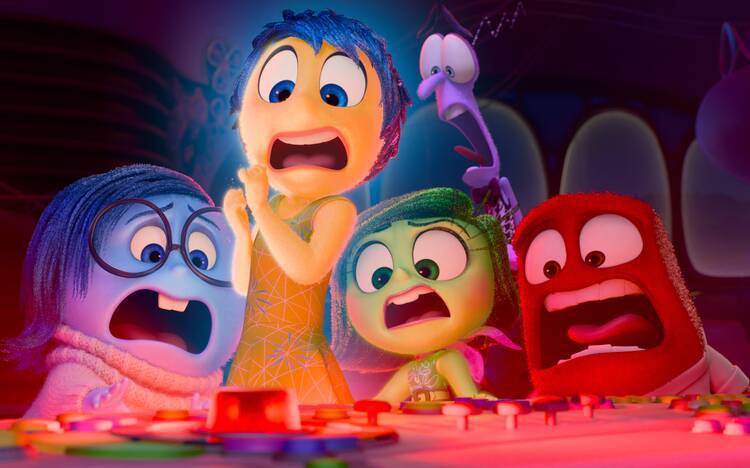“Inside Out 2” is the latest Pixar summer entertainment juggernaut. It’s beautifully rendered, funny and thoughtful, as one might expect of Pixar, and delivers young viewers a positive message about remaining true to core values including loyalty, honesty and kindness. I went to see it with my three older kids, and we enjoyed it very much. Nonetheless, something about it left me troubled—saddened, even.
As in the first “Inside Out,” protagonist Riley’s emotions are represented by vivid characters, and tenets of psychology are creatively depicted through the dramatic action. In the sequel, Riley (now 13) grapples with new psychological challenges—specifically, the emergence of Anxiety as a powerful emotion—and has to learn to achieve psychic equilibrium over the course of a three-day ice hockey camp.
In the film, a structural addition to Riley’s inner landscape (distinct from the control room from which her emotions steer her, and the endless Amazon-style warehouses of her old memories) is the sense-of-self tree. It’s a pristine, sky-blue crystalline structure that resonates like a stringed instrument. Once Anxiety arrives in the control room, she and other newcomers—Envy, Ennui and Embarrassment—wrest control of Riley’s thoughts and behaviors and execute a coup, sending the longer-standing emotions into exile.
Anxiety is never presented as a villain; at worst she’s an anti-villain, obsessively intent on protecting Riley and steering her toward a specific vision of worldly success and safety. Nevertheless, the net effect of Anxiety’s interference is an unintentional moral corruption of the girl, symbolized by the warping of the sense-of-self tree into a jagged configuration in an ugly shade of orange.
Through conversations with my college-aged students over the years I have learned that Disney, and especially Pixar, loom large in their worldviews. Perhaps this should come as no surprise given the genius of Pixar’s first films, the sheer dominance of the House of Mouse in the culture at large, and the impressionable age of Disney’s target audience. It is no secret that Disney refers to its army of story and image designers as “imagineers,” and it is hard for me not to hear in the neologism echoes of Stalin’s notion of artists being the “engineers of the soul.” Which is to say: they decide what the dominant metaphors for the future will be, and whom or what they will serve.
The linguist and neuroscientist George Lakoff argues that we live primarily through metaphor—that it molds, imperceptibly, every aspect of our experience, including our sense of who and what we are, our relationships, and even how we perceive time and space. (A simple example from Lakoff is the concept of time as a moving object, bringing events toward us through space: “I can’t wait for the arrival of Christmas.”) Just as noteworthy is how wholly common metaphors blind us to alternative models of reality. Every new cultural age brings with it a new set of metaphors, which inculcate in us new models of what we are, what sort of world we inhabit, and what our goals should be. We become blind, without knowing it, to old ways of seeing and feeling.
Pixar’s dominant metaphors for the good often revolve around labor, and more specifically the modern corporate American workplace. The “Inside Out”universe is illustrative: Riley’s consciousness is structured like a TV control room that oversees a complex of cognitive functions, all staffed by vast numbers of low-level employees (like cleaners and construction workers). Or consider “Toy Story,” which depicts toys as essentially child care employees/therapists, with Woody as their manager, or “Monsters, Inc.” sees kids’ emotions (namely fear) as central to a high-tech monster economy. Even the more spiritual setting of “Soul” seems like a cross between a Silicon Valley campus and the Esalen Institute.
I don’t perceive Pixar as malevolently manipulative. But just as Anxiety mobilizes Riley’s unconscious to believe things that are “good for her,” no ill will is required for cultural products to blind us to other, maybe healthier ways of thinking. In the mid-20th century, the social theorist Philip Rieff conceived of three major types (or dominant metaphors) supplying Western civilization with its leitmotifs: Greco-Roman “Political Man,” followed by the Jewish and medieval “Religious Man,” and now the era of “Psychological Man.” In The Triumph of the Therapeutic—Uses of Faith After Freud, Rieff defines the latter two terms this way: “Religious man was born to be saved, psychological man is born to be pleased.”
There is an implicit loneliness in that word “pleased” that haunts me. Maybe it’s the etymological link to the Latin placare: to soothe or quiet oneself, having lost access to a divine that might offer comfort. Or perhaps it’s the implication that everything is destined to become entertainment, according to a model of the world as a set of commodities and services that one finds satisfactory or not. In the search for being “pleased” there is no role for sacrifice—no place for the heroic, and, ultimately, no sense of higher meaning that gives sustenance. Understandably, many are retreating ever further into a private self, with its private entertainments and self-contained wants and desires.
By the end of the film, Riley learns to shade the simplistic core beliefs of childhood (“I’m a good person”) with more nuanced, sometimes negative self-appraisals, such as the realization that she can be selfish, or even cruel. This more integrated sense of self is mature and realistic. Inside, Riley learns to accept herself warts and all, and “outside” she is embraced by her old friends and her new teammates.
It is a happy ending—triumphant, even. But the poignancy I felt upon reflection is that this ending is a “triumph” in Rieff’s ironic sense: a triumph of Psychological Man and of what we could call therapy culture. Riley is always fundamentally alone. Her sense-of-self tree grows toward no transcendent goal; it is rooted to nothing more lasting than the lifespan of her own psyche. Her ideals remain her own private achievements and pleasures.
So many of my students have everything going for them—talent, opportunity, drive—but something gnaws at them. If they are building a tree in their souls, how deep and strong are the roots? What is it growing toward?
In the wake of the critical and commercial success of the original “Inside Out,” its director Pete Docter (a Christian who has discussed his faith in America) did not feel pleased. On the contrary, he experienced a strange emptiness. His next film, “Soul,” was about Joe Gardner, a jazz musician who finally achieves his dreams on stage, only to realize that meaning lies elsewhere—in spiritual life, predicated on seeing the divine in small things and communing deeply with others. (In Joe’s case, he takes a personal risk to coax an unborn soul into trusting that earthly life is worth living.)
I understand why Pixar would avoid proselytizing for any religious or transcendental perspective; this reticence is appropriate in a secular culture. But acknowledging the value of making sacrifices for a good that transcends the inward-looking sphere of pleasures and personal achievements is important. Talented minds are implanting ideals in the inner landscapes of our young. Let them invoke strong, connected root networks rather than elegant but solitary trees.








